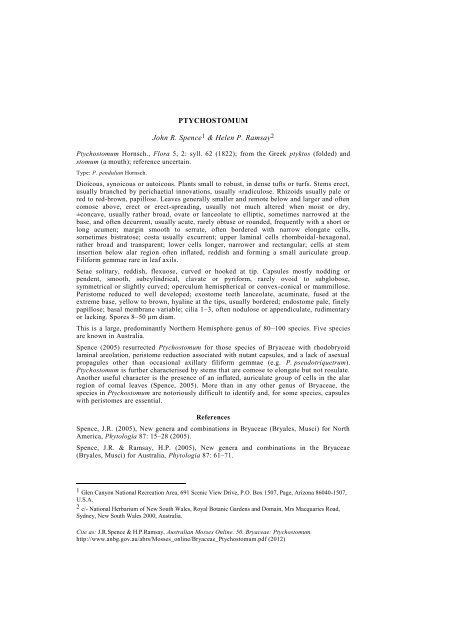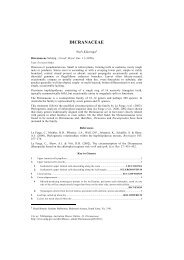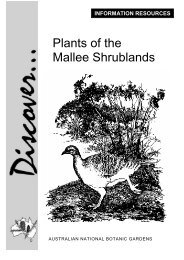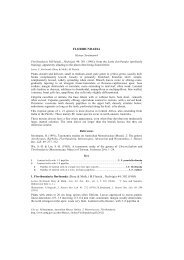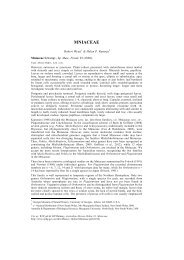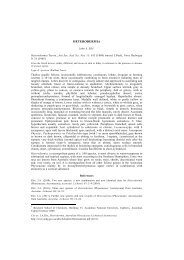Ptychostomum - Australian National Botanic Gardens
Ptychostomum - Australian National Botanic Gardens
Ptychostomum - Australian National Botanic Gardens
Create successful ePaper yourself
Turn your PDF publications into a flip-book with our unique Google optimized e-Paper software.
PTYCHOSTOMUM<br />
John R. Spence 1 & Helen P. Ramsay 2<br />
<strong>Ptychostomum</strong> Hornsch., Flora 5, 2: syll. 62 (1822); from the Greek ptyktos (folded) and<br />
stomum (a mouth); reference uncertain.<br />
Type: P. pendulum Hornsch.<br />
Dioicous, synoicous or autoicous. Plants small to robust, in dense tufts or turfs. Stems erect,<br />
usually branched by perichaetial innovations, usually ±radiculose. Rhizoids usually pale or<br />
red to red-brown, papillose. Leaves generally smaller and remote below and larger and often<br />
comose above, erect or erect-spreading, usually not much altered when moist or dry,<br />
±concave, usually rather broad, ovate or lanceolate to elliptic, sometimes narrowed at the<br />
base, and often decurrent, usually acute, rarely obtuse or rounded, frequently with a short or<br />
long acumen; margin smooth to serrate, often bordered with narrow elongate cells,<br />
sometimes bistratose; costa usually excurrent; upper laminal cells rhomboidal-hexagonal,<br />
rather broad and transparent; lower cells longer, narrower and rectangular; cells at stem<br />
insertion below alar region often inflated, reddish and forming a small auriculate group.<br />
Filiform gemmae rare in leaf axils.<br />
Setae solitary, reddish, flexuose, curved or hooked at tip. Capsules mostly nodding or<br />
pendent, smooth, subcylindrical, clavate or pyriform, rarely ovoid to subglobose,<br />
symmetrical or slightly curved; operculum hemispherical or convex-conical or mammillose.<br />
Peristome reduced to well developed; exostome teeth lanceolate, acuminate, fused at the<br />
extreme base, yellow to brown, hyaline at the tips, usually bordered; endostome pale, finely<br />
papillose; basal membrane variable; cilia 1–3, often nodulose or appendiculate, rudimentary<br />
or lacking. Spores 8–50 µm diam.<br />
This is a large, predominantly Northern Hemisphere genus of 80–100 species. Five species<br />
are known in Australia.<br />
Spence (2005) resurrected <strong>Ptychostomum</strong> for those species of Bryaceae with rhodobryoid<br />
laminal areolation, peristome reduction associated with nutant capsules, and a lack of asexual<br />
propagules other than occasional axillary filiform gemmae (e.g. P. pseudotriquetrum).<br />
<strong>Ptychostomum</strong> is further characterised by stems that are comose to elongate but not rosulate.<br />
Another useful character is the presence of an inflated, auriculate group of cells in the alar<br />
region of comal leaves (Spence, 2005). More than in any other genus of Bryaceae, the<br />
species in <strong>Ptychostomum</strong> are notoriously difficult to identify and, for some species, capsules<br />
with peristomes are essential.<br />
References<br />
Spence, J.R. (2005), New genera and combinations in Bryaceae (Bryales, Musci) for North<br />
America, Phytologia 87: 15–28 (2005).<br />
Spence, J.R. & Ramsay, H.P. (2005), New genera and combinations in the Bryaceae<br />
(Bryales, Musci) for Australia, Phytologia 87: 61–71.<br />
1 Glen Canyon <strong>National</strong> Recreation Area, 691 Scenic View Drive, P.O. Box 1507, Page, Arizona 86040-1507,<br />
U.S.A.<br />
2 c/- <strong>National</strong> Herbarium of New South Wales, Royal <strong>Botanic</strong> <strong>Gardens</strong> and Domain, Mrs Macquaries Road,<br />
Sydney, New South Wales 2000, Australia.<br />
Cite as: J.R.Spence & H.P.Ramsay, <strong>Australian</strong> Mosses Online. 50. Bryaceae: <strong>Ptychostomum</strong>.<br />
http://www.anbg.gov.au/abrs/Mosses_online/Bryaceae_<strong>Ptychostomum</strong>.pdf (2012)
1 Synoicous; peristome reduced, with a low basal membrane; cilia usually short; spores mostly > 20 µm diam.<br />
. ..................................................................................................................................... 1. P. altisetum<br />
1: Dioicous or synoicous; peristome well developed; spores < 20 µm diam. ............................................. 2<br />
2 Plants 1–5 (–10 cm) tall; stems elongate, with equidistant decurrent leaves, usually strongly<br />
tomentose, sparingly branched; laminal cells distinctly incrassate; costa percurrent to shortexcurrent;<br />
leaf border strong; upper margin denticulate (1:) .......................... 5. P. pseudotriquetrum<br />
2: Plants to 3 cm tall; leaves densely tufted, comose, not decurrent, tomentose below; laminal cells<br />
mostly thin-walled; costa short- to more commonly long-excurrent; leaf border variable, sometimes<br />
weak; upper margin usually entire or finely serrulate ....................................................................... 3<br />
3 Synoicous; leaf border distinct (2:) .......................................................................... 3. P. creberrimum<br />
3: Dioicous; leaf border weak or almost lacking ....................................................................................... 4<br />
4 Leaves ovate to ovate-lanceolate; upper and middle laminal cells elongate, 50–70 × 10–12 µm<br />
(5–6: 1) (3:)........................................................................................................ 2. P. angustifolium<br />
4: Leaves ovate to obovate; upper and middle laminal cells shorter and broader, 30–60 × 12–18 µm<br />
(3–4: 1) .......................................................................................................... 4. P. cylindrothecium<br />
1. <strong>Ptychostomum</strong> altisetum (Müll.Hal.) J.R.Spence & H.P.Ramsay, Phytologia 87:<br />
63 (2005)<br />
Bryum altisetum Müll.Hal., Hedwigia 37: 96 (1898). T: Moyston, Vic., Oct. 1883, D.Sullivan 551; lecto: H,<br />
fide H.Ochi, J. Fac. Educ. Tottori Univ. Nat. Sci. 21: 43 (1970); Dimboola, Vic., Oct. 1893, F.M.Reader 4;<br />
syn: H; near Hot Springs, Yarrangobilly Caves, N.S.W., W.W.Watts 8565; syn: NSW.<br />
Bryum humilisetum Müll.Hal., Hedwigia 37: 97 (1898), nom. inval. (in synon.); Bryum altisetum Müll.Hal. var.<br />
humilisetum Müll.Hal., Hedwigia 37: 96 (1898). T: Moyston, Vic., Oct. 1883, D.Sullivan 14d; holo: MEL.<br />
[Bryum inclinatum auct. non (Brid.) Bland: D.G.Catcheside, Mosses of South Australia 253 (1980)]<br />
Illustrations H.Ochi, J. Fac. Educ. Tottori Univ. Nat. Sci. 21: 44, fig. 25 (1970), as Bryum altisetum;<br />
A.J.E.Smith, Moss Flora of Britain and Ireland 398, fig. 187 (6–11) (1978), as Bryum inclinatum;<br />
D.G.Catcheside, Mosses of South Australia 254, fig. 145 (1980), as Bryum inclinatum.<br />
Synoicous. Plants to 10 mm tall, loosely to densely tufted, yellowish green. Leaves crowded<br />
above in comal tufts, appressed and straight to somewhat crisped when dry, erecto-patent<br />
when moist, ovate-lanceolate to oblong-lanceolate, 1.5–3.0 mm long, not or weakly<br />
decurrent, acuminate; base of leaf reddish; leaves of sterile innovations somewhat smaller<br />
and imbricate, concave; margin recurved, finely denticulate above, bordered by 3 or 4 rows<br />
of very narrow incrassate cells; costa short- to long-excurrent, yellowish to brown; upper and<br />
middle laminal cells 40–70 × 10–15 µm (3–4: 1), thin-walled; basal cells long-rectangular;<br />
angular cells at insertion of comal leaves inflated and reddish.<br />
Setae slender, 10–20 mm long. Capsules inclined to pendulous, narrowly pyriform, 1.5–3.5<br />
mm long, symmetrical; mouth yellowish; operculum mammillose. Peristome reduced;<br />
exostome teeth reddish below, yellow above, with lamellae; endostome segments with broad<br />
perforations, papillose along mid-line; basal membrane low; cilia rudimentary or 1 or 2 and<br />
short. Spores 18–25 µm diam. Chromosome number not known.<br />
Occurs in N.S.W., A.C.T. and Vic. and, possibly, in New Zealand. Grows in tufts on soil and<br />
rock, predominantly subalpine to alpine in Australia.<br />
N.S.W.: Yarrangobilly Caves, A.J.Downing s.n. (NSW); loc. id., W.W.Watts 8551 (NSW); Snowy<br />
Mtns, D.G.Catcheside 54.70 (AD). A.C.T.: Warks Rd, Brindabella Ra., H.Streimann 4749 (CANB).<br />
Vic.: Echo Flat, Lake Mtn, near Marysville, J.H.Willis 77 (MEL).<br />
<strong>Ptychostomum</strong> altisetum is most similar to Bryum inclinatum, a widespread, montane species<br />
in the Northern Hemisphere. However, there are subtle differences between the two species<br />
in leaf and peristome characters, and we prefer to maintain P. altisetum as a distinct species<br />
pending a worldwide revision.<br />
2
2. <strong>Ptychostomum</strong> angustifolium (Brid.) J.R.Spence & H.P.Ramsay, in J.R.Spence,<br />
Phytologia 87: 23 (2005)<br />
Bryum angustifolium Brid., Muscol. Recent., Suppl. 3: 31 (1817).<br />
T: Germany; n.v.<br />
Bryum caespiticium Hedw., Sp. Musc. Frond. 180 (1801), non <strong>Ptychostomum</strong> caespiticium Brid., Bryol. Univ.<br />
1: 837 (1827). T: Europe; n.v.<br />
Bryum caespiticium Hedw. var. crinitum Wilson, in J.D.Hooker, Fl. Tasman. 2: 191 (1859).<br />
[Hobart], Tas., R.C.Gunn 24; syn: BM; Port Sorrell, Tas., W.Archer; syn: BM.<br />
T: Hobarton<br />
Bryum laxirete Broth., Proc. Linn. Soc. New South Wales 41: 588 (1916). T: Emu Plains, N.S.W.,<br />
W.Forsyth 1019; syn: H-BR; Warrumbungle Ra., N.S.W, W.Forsyth 1022; syn: H-BR; Jenolan Caves, N.S.W.,<br />
Blakely 970; syn: H-BR; isosyn: NSW; Hill Top, N.S.W., J.H.Maiden 406; isosyn: NSW; near Barbers Creek,<br />
N.S.W., W.Forsyth 409. syn: H-BR.<br />
Bryum capitellatum Müll.Hal. ex Watts & Whitel., Proc. Linn. Soc. New South Wales 30 (Suppl.): 130 (1906),<br />
nom. nud. Based on: Vic., 2 Aug. 1896, F.M.Reader (MEL).<br />
Illustrations: H.C.Gangulee, Mosses of Eastern India and Adjacent Regions 2: 996, fig. 483 (1974);<br />
A.J.E.Smith, Moss Flora of Britain and Ireland 413, fig. 196 (1–4) (1978); D.G.Catcheside, Mosses of South<br />
Australia 265, fig. 154 (1980), all as Bryum caespiticium.<br />
Dioicous. Plants 10–20 mm tall, densely tufted, pale bright silky green above, brownishtomentose<br />
below. Stems slender, comose, with slender innovations. Leaves scarcely or slightly<br />
twisted when dry, imbricate, erect when moist; uppermost leaves forming a crowded coma,<br />
ovate to oblong lanceolate, widest below middle, not decurrent, acuminate; innovation leaves<br />
smaller, ovate and strongly concave; margin revolute almost to apex, ±entire; marginal cells<br />
narrow but not forming a distinct border; costa usually excurrent in a long entire arista,<br />
yellowish to reddish brown; laminal cells narrowly hexagonal to rhomboidal, 50–70 × 10–12 µm<br />
(5–6: 1), thin-walled; basal cells long rectangular; angular walls of alar region of comal<br />
leaves swollen, pinkish.<br />
Setae slender, 10–20 mm long. Capsules oblong-pyriform or clavate, 2.0–2.5 mm long,<br />
cernuous or pendulous; apophysis thick, often somewhat gibbous, shorter than urn, tapering<br />
to the seta; mouth wide; operculum, convex, slightly apiculate. Exostome teeth pale brown;<br />
endostome segments broadly perforate; basal membrane high, half the length of the<br />
exostome; cilia 2, long-appendiculate. Spores 10–16 µm diam. n = 30, fide H.P.Ramsay &<br />
J.R.Spence, J. Hattori Bot. Lab. 80: 260 (1996), as Bryum caespiticium;<br />
“n = 20” is an error.<br />
Occurs in W.A., N.T., S.A., N.S.W., A.C.T. Vic. and Tas.; common on dry sandy or silty<br />
soils and rocks especially in mallee or sclerophyll scrub. A ±cosmopolitan species in<br />
temperate regions, but rare in the tropics.<br />
W.A.: Wansborough Walk to Granite Domes, Porongurup Natl Park, J.R.Spence 4196 (NSW). N.T.: Kakadu Natl<br />
Park, L.A.Craven 6145A (CANB). S.A.: Glenelg R., D.G.Catcheside 55.130 (AD). N.S.W.: Warrumbungle<br />
Ra., W.Forsyth 1022 (NSW). A.C.T.: Two Sticks Rd, near Piccadilly Circus, Brindabella Ra., N.T.Burbidge<br />
7065 (CANB). Vic.: Manna Falls, near Hamilton, H.P.Ramsay 8/77, 9/77 (NSW).<br />
The elongate, thin-walled laminal cells, the absence of a distinct leaf border, and the longexcurrent<br />
hairpoint are diagnostic.<br />
3. <strong>Ptychostomum</strong> creberrimum (Taylor) J.R.Spence & H.P.Ramsay, in J.R.Spence,<br />
Phytologia 87: 23 (2005)<br />
Bryum creberrimum Taylor, London J. Bot. 5: 54 (1846).<br />
Bryum affine Schultz, Flora 54: 476 (1871), nom. illeg. (later homonym).<br />
holo: n.v.<br />
T: Swan River, W.A., J.Drummond s.n.; holo: BM.<br />
T: Swan R., W.A., J.Drummond s.n.;<br />
[Bryum intermedium auct. non (Brid.) Bland: H.Streimann & N.Klazenga, Cat. Austral. Mosses 33 (2002)]<br />
Illustrations: A.J.E.Smith, Moss Flora of Britain and Ireland 410, fig. 194 (5–8) (1978); D.G.Catcheside,<br />
Mosses of South Australia 255, fig. 146 (1980), both as Bryum intermedium.<br />
Synoicous. Plants 10–30 mm tall, densely tufted, yellow-green above, reddish brown below,<br />
tomentose. Stems comose, branched. Leaves erecto-patent when moist, a little twisted when<br />
dry, lanceolate to ovate-lanceolate, not decurrent, tapering to an acuminate apex; margin<br />
strongly recurved, entire or denticulate near apex; costa reddish, excurrent in a short point;<br />
3
middle and upper laminal cells rhomboidal to hexagonal, 40–70 × 10–15 µm (3–4: 1), thinwalled;<br />
several marginal rows of longer narrower more incrassate cells forming a distinct<br />
border; basal cells long-rectangular; cells in lower alar region of comal leaves inflated,<br />
reddish.<br />
Setae slender, 15–30 mm long. Capsules inclined to pendulous, symmetrical, narrowly<br />
pyriform, 2.5–3.5 mm long; operculum mammillose. Peristome well developed; exostome<br />
teeth narrowly lanceolate, brownish red; endostome segments with long perforations, c. as<br />
wide as long; basal membrane to c. half the height of the teeth; cilia 2, appendiculate. Spores<br />
14–16 µm diam. n = 30, fide H.P.Ramsay & J.R.Spence, J. Hattori Bot. Lab. 80: 260 (1996),<br />
as Bryum creberrimum.<br />
Widespread in W.A, S.A., N.S.W., A.C.T., Vic. and Tas.; uncommon on soil or in rock<br />
crevices, prefers sandy, basic substrata. A pantemperate species in both hemispheres.<br />
W.A.: Two Peoples Bay Nature Reserve, 30 km E of Albany, R.Wyatt & A.Stoneburner 3769 (PERTH).<br />
S.A.: Lees Springs, D.G.Catcheside 54.38 (AD). N.S.W.: trail above Blue L., Charlotte Pass, Kosciuszko<br />
Natl Park, J.R.Spence 4748 (NSW). A.C.T.: Brumby Flats, Brindabella Ra., L.Craven 545 (CANB).<br />
Vic.: Bogong High Plains, J.H.Willis s.n. (MEL). Tas.: Orford, 23 Sept. 1984, D.G.Catcheside (AD).<br />
<strong>Ptychostomum</strong> creberrimum can be distinguished by its synoicous perichaetia, elongate thinwalled<br />
laminal cells, leaf border and usually short-excurrent costa. This is very similar to the<br />
Northern Hemisphere species Bryum lisae De Not.<br />
4. <strong>Ptychostomum</strong> cylindrothecium (R.Br.ter.) J.R.Spence & H.P.Ramsay, Phytologia<br />
87: 63 (2005)<br />
Bryum cylindrothecium R.Br.ter., Trans. & Proc. New Zealand Inst. 31: 452 (1899).<br />
Zealand, Apr. 1882, R.Brown; holo: CHR.<br />
T: Waikari, New<br />
Dioicous. Plants in dense tufts to 15 mm tall, yellowish green above. Stems branched by a<br />
few perichaetial innovations, brownish-tomentose below. Leaves crowded in the upper part<br />
of the stem; lower leaves closely imbricate when dry, not much altered when moist, ovate or<br />
obovate with an acute apex and a non-decurrent base, to 1.5 mm long, strongly concave,<br />
innovation leaves smaller; margin plane or slightly reflexed in median to basal parts, entire;<br />
costa strong, long-excurrent with an arista, red towards the base; laminal cells thin-walled,<br />
hexagonal or rhomboidal-hexagonal, to 30–60 × 12–18 µm (3–4: 1); basal cells rectangular,<br />
indistinctly bordered by 1 or 2 rows of thin-walled more elongate cells; alar region of<br />
slightly inflated pinkish cells.<br />
Setae slender, erect, to 15–20 mm long. Capsules nutant to subpendulous, oblong-pyriform,<br />
3.0–3.5 mm long, pale brown; operculum convex, slightly apiculate. Peristome well<br />
developed; exostome teeth pale brown; endostome segments perforate; basal membrane high ,<br />
half the length of the exostome; cilia 2 or 3, appendiculate. Spores 10–12 µm diam.<br />
Chromosome number not known.<br />
Occurs on sandy soil in southern S.A.; also in New Zealand. Reported here for the first time<br />
from Australia.<br />
S.A.: Kangaroo Is., 28 Aug. 1948, H.B.S.Womersley (AD); Coorong, opposite Campbell Pt, V.Levitzke 968 (AD).<br />
<strong>Ptychostomum</strong> cylindrothecium can be separated from P. angustifolium by its distinctive leaf<br />
shape and broader laminal cells.<br />
5. <strong>Ptychostomum</strong> pseudotriquetrum (Hedw.) J.R.Spence & H.P.Ramsay, in J.R.Spence,<br />
Phytologia 87: 23 (2005)<br />
Mnium pseudotriquetrum Hedw., Sp. Musc. Frond. 190 (1801); Bryum pseudotriquetrum (Hedw.) Schwägr.,<br />
Sp. Musc., Suppl. 1, 2: 110 (1816). T: Europe; n.v.<br />
Bryum ventricosum Dicks. ex Relh., Fl. Cantab. 2nd edn, 427 (1802), nom. illeg.<br />
Bryum tasmanicum Hampe, Linnaea 25: 714 (1853).<br />
MEL.<br />
T: Europe; n.v.<br />
T: Van Diemensland, [Tas.], 1850, Stuart; holo: BM; iso:<br />
4
Bryum rubiginosum Hook.f. & Wilson, in J.D.Hooker, Fl. Tasman. 2: 190 (1859).<br />
R.C.Gunn; holo: MEL.<br />
T: St. Patricks, Tas.,<br />
Bryum austroaffine Broth., Proc. Linn. Soc. New South Wales 41: 587 (1916). T: Yarrangobilly Caves,<br />
N.S.W., W.Forsyth 1012, 1014; syn: H-BR; isosyn: NSW; Kiandra, N.S.W., W.Forsyth 1010, 1011; syn: H-BR;<br />
isosyn: MEL, NSW.<br />
Bryum subventricosum Broth., Proc. Linn. Soc. New South Wales 41: 586 (1916).<br />
W.Forsyth 725; holo: H-BR; iso: NSW.<br />
T: Tumbarumba, N.S.W.,<br />
Bryum subpseudotriquetrum Broth. ex Burges, Proc. Linn. Soc. New South Wales 60: 93 (1935), nom. nud.<br />
Based on: Tumbarumba, N.S.W., W.Forsyth 725 (NSW).<br />
Illustrations: H.Ochi, J. Fac. Educ. Tottori Univ. Nat. Sci. 21: 45, fig. 26A–F (type of Bryum tasmanicum); G–J<br />
(syntype of Bryum austroaffine); 46, fig. 27A–G (type of Bryum subventricosum); H (Bryum rubiginosum)<br />
(1970); D.G.Catcheside, Mosses of South Australia 260, fig. 150 (1980), as Bryum pseudotriquetrum;<br />
R.D.Seppelt, The Moss Flora of Macquarie Island 109 fig. 42 (2004), as Bryum pseudotriquetrum.<br />
Dioicous in Australia. Plants 1–5 (–10) cm tall, in dense tufts or open mats, glossy, greenish to<br />
reddish. Stems densely matted below with red-brown rhizoids. Leaves uniform and equidistant<br />
on stem, crowded at apex, shrunken when dry, erecto-patent when moist, ovate to ovatelanceolate,<br />
2.0–3.5 mm long, decurrent, acute; margin recurved, denticulate above, decurrent;<br />
costa stout, percurrent to short-excurrent, reddish brown; upper laminal cells broadly<br />
hexagonal, 20–40 × 12–20 µm (2–3: 1), incrassate; elongate marginal cells forming a distinct<br />
border; basal cells short- to long-rectangular, reddish; alar region of comal leaves with a group<br />
of larger inflated cells.<br />
Setae slender, mostly straight, 10–30 mm long. Capsules ±pendulous, broadly pyriform, 3.0–<br />
4.5 mm long; operculum conical. Peristome well developed; exostome teeth orange-brown<br />
below, papillose at tips; endostome segments broadly perforate; basal membrane half the height<br />
of the exostome; cilia 2 or 3, filiform, long-appendiculate. Spores 12–18 µm diam., finely<br />
papillose. Chromosome number not known.<br />
Occurs in N.S.W, A.C.T., Vic. and Tas. A plant of wet soils, fens, wet heaths and marshes,<br />
usually low-alpine, but also in lowland acidic marshes. Also in Europe, Asia, North and<br />
South America, West Africa, New Zealand and Antarctica.<br />
N.S.W.: Mt Kosciuszko, D.G.Catcheside 54.66 (AD). A.C.T.: Tidbinbilla, 18 Mar. 1975, D.G.Catcheside<br />
(NSW). Vic.: Bogong High Plains, 17 Jan. 1970, M.Blackwood (AD). Tas.: Mt Wellington, A.V.Ratkowsky<br />
H573 (CANB).<br />
<strong>Ptychostomum</strong> pseudotriquetrum is characterised by its comparatively large size, the<br />
elongate, densely tomentose stems, decurrent leaves with a short, stout point and broad,<br />
incrassate upper laminal cells. Northern Hemisphere populations occasionally produce<br />
filiform gemmae in the leaf axils as in Rosulabryum, and also include shorter, comose<br />
synoicous forms that have not been seen in Australia. Gemmabryum laevigatum often grows<br />
with P. pseudotriquetrum, but it is readily distinguished by its obtuse leaves, extremely<br />
dense areolation, and the absence of dense tomentum on the stems.<br />
5


